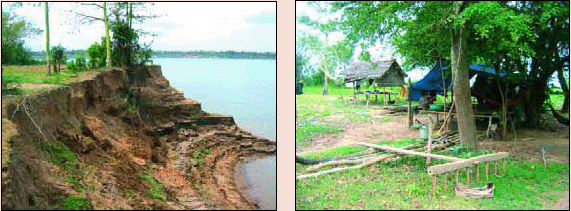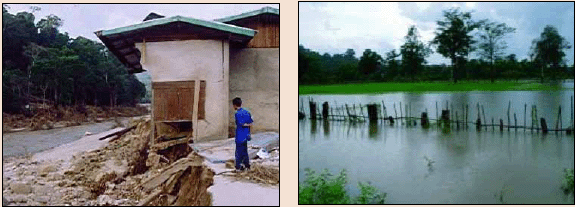7. Impact of the 2005 flood - Country reports (cont')
7.2 Impact of the 2005 flood in Lao PDR
7. 2.1 Background
The hydrological network in Lao PDR is characterised by numerous tributaries, flowing to the Mekong, which drain large and mountainous catchment areas. This means that when strong rainfalls occur in those catchments, those rivers may generate severe and damaging flash floods before reaching the Mekong. These flash floods are not easily predictable due to the lack of hydrological stations on the tributaries and due to the difficulties of estimating rainfall which may be subject to a considerable spatial variation. The observation of tropical storms remains, at the moment, the best way for forecasting possibilities of such flash floods. Unexpected flood situations like this may make it difficult to be prepared. The intensity of the water flow is a major danger for human life and livestock and a source of damage to infrastructure such as bridges, roads and irrigation structures. The damage to cultivated areas is less important, except for areas located near the streams. Rice fields may be inundated up to 15 days without irreversible damage, while the duration of such flows is much shorter. Nearly every year, severe flash floods occur in the country but location may vary from one year to another. Nevertheless, regarding flash floods, the year 2005 was exceptionally favourable for flash floods in Lao PDR.

Erosion of the river bank is a serious issue. The picture on the left shows severe bank erosion that took a house away. Resettlement is also a major problem. those who lose their houses often have no place to resettle and no money for reconstruction. The picture on the right shows the resettlement of the owner of the same house washed away by erosion. A family member provided some land and very little external support was reported received. Solidarity between the community members is sometimes very low due to the extreme precariousness of the people’s livelihoods.
When such tributary flows approach the Mekong, the situation may be quite different. Severe and long duration flooding events can be recorded if two conditions are simultaneously fulfilled: high flow in the tributary and high water levels in the Mekong. Prediction of such events requires a good knowledge of the hydrological conditions in the upper section of the tributaries and the rainfall depth and intensity in their basins as well as the ability to forecast the level of the Mekong. People living in such areas are accustomed to facing floods and are more prepared than people living in "flash flood" risk areas. Damage to houses and livestock is often limited. The most severe damage is caused to the paddy fields that may be flooded for long periods. This kind of flooding event occurs nearly every year, although serious damage to paddy fields is less frequent and depends on the duration of the flood.
The Mekong itself may sometimes reach such a high level that it overflows its banks. Some of the lowest points in the embankment may be source of local flooding that may affect villages located nearby. For such situations, flood forecasting may be of considerable help for early warning and preparedness. Severe damage from such floods does not occur often, although years 2000, 2001 and 2002 were considered as severe floods for those in proximity to the river embankment. Mekong River bank erosion is also a major concern for Lao PDR whatever the flood intensity.
In summary, in Lao PDR, the flood is generally considered as a source of problems more than a source of benefits. Other than those who have embankments to protect their paddy fields (and this is not common), the farmers who live in flood risk areas fear lose all or a significant part of their production every year. Fishing activity in fish ponds may also be affected by flood.
7.2.2 Availability of data
In Lao PDR, data are centralised at provincial level, through the Provincial Disaster Management Committees (PDMCs), in which the technical departments and the districts are represented. Data are collected from the field by technical departments. In addition, the village chiefs often keep records of the damage, with a major focus on paddy fields.

In Lao PDR, flood is generally seen as a source of problems.
In 2005, infrastructure were severely affected by flash floods
and from long periods of flood in the low-lying areas located
close to the Mekong River. Long flooding periods affected
the paddy fields and ruined farmers' incomes. Fish production
carried out in fish ponds was also affected by the excessive
flooding.

In Piaka District of Champone, in Savannakhet, the Village Head was able to show a very precise inventory of the damage caused by the 2005 flood. In his book, he had written the names of heads of families, the number of people living in the family and for each farmer, the area planted and the area destroyed. As the village was concerned about having sufficient seedlings for replanting, the seedling damage was also reported. As the village expects to be flooded every year, damage to livestock and other assets was generally limited, and was not recorded precisely.
The reliability and coherence of the data collected at provincial levels, strongly depends on the coordination quality of the Provincial Committees and on the severity of the flood. In some provinces, eg Khammouan, which was particularly affected by 2005 flood, an exhaustive report was prepared in 2005, including a table of damage, PowerPoint presentations and pictures. In other provinces, data were not reconciled nor validated at Committee level and discrepancies in the figures collected by the different institutions may be observed. In some places data are not available at all.
At central level, data are collected through two means. The Technical Departments have their own reporting from their provincial branch offices, while the National Disaster Management Organisation (NDMO) collects the information from the Provincial Committees. This may also generate some inconsistencies when comparing the consolidated figures.
For the time being, a considerable effort is being made in Lao PDR to obtain more exhaustive and accurate data on flood damage. Nevertheless, there is a strong need to improve coordination and data flow procedures to gather those data at the central level.
Choose a newsletter: